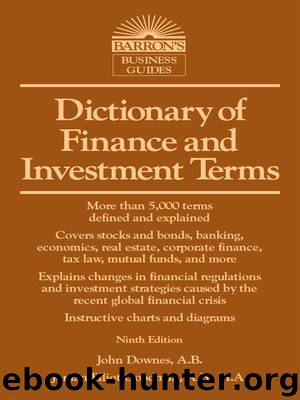Dictionary of Finance and Investment Terms by John Downes

Author:John Downes
Language: eng
Format: epub
Publisher: Barron's Educational Series, Inc.
Published: 2014-01-13T16:00:00+00:00
M-1, M-2, and M-3 three measures of the money supply as defined by the Federal Reserve Board:
M1 is the narrowest measure of money supply. It includes currency in circulation, checking account balances, NOW accounts and share draft accounts at credit unions, and travelers’ checks. M1 represents all money that can be spent or readily converted to cash for immediate spending.
M2 includes everything in M1 plus savings accounts and time deposits such as CDs, money market deposit accounts, and repurchase agreements.
M3 includes everything in M2 plus large CDs and money market fund balances held by institutions. M3 is the broadest measure of money supply tracked by the Fed.
Federal Reserve policymakers carefully watch the growth rate of all three money supply measures, but especially M2, as key indicators of economic growth and the potential for inflation. Most economists maintain that most economic growth and inflation is determined by the rate of growth in the money supply.
MONETARIST economist who believes that the MONEY SUPPLY is the key to the ups and downs in the economy. Monetarists such as Milton Friedman think that the money supply has far more impact on the economy’s future course than, say, the level of federal spending—a factor on which KEYNESIAN ECONOMICS puts great stress. Monetarists advocate slow but steady growth in the money supply.
MONETARY AGGREGATES classifications of the MONEY SUPPLY. Since early 2006, the Federal Reserve has been issuing data on only two of the aggregates: M1 (including M0, which is currency in circulation) and M2, which includes M1 and balances that can be readily converted to M1 without significant loss of principal. M3 stopped being published in March 2006. (It had included M2 plus certain accounts held by entities other than individuals and issued by banks and thrifts to augment M2-type balances in meeting credit demands. Also included were money market funds held by institutional investors).
MONETARY BASE a country’s total currency in circulation, including money in the hands of the public and in commercial bank deposits held in the reserves of the central bank. Not to be confused with MONEY SUPPLY, which includes non-bank deposits with commercial banks.
MONETARY INDICATORS economic gauges of the effects of MONETARY POLICY, such as various measures of credit market conditions, U.S. Treasury BILL rates, and the Dow Jones Industrial Average (of common stocks).
MONETARY POLICY FEDERAL RESERVE BOARD decisions on the MONEY SUPPLY. To make the economy grow faster, the Fed can supply more credit to the banking system through its OPEN MARKET OPERATIONS, or it can lower the member bank reserve requirement or lower the DISCOUNT RATE—which is what banks pay to borrow additional reserves from the Fed. If, on the other hand, the economy is growing too fast and inflation is an increasing problem, the Fed might withdraw money from the banking system, raise the reserve requirement, or raise the discount rate, thereby putting a brake on economic growth. Other instruments of monetary policy range from selective credit controls to simple but often highly effective MORAL SUASION. Monetary policy differs from FISCAL POLICY, which is carried out through government spending and taxation.
Download
This site does not store any files on its server. We only index and link to content provided by other sites. Please contact the content providers to delete copyright contents if any and email us, we'll remove relevant links or contents immediately.
Periodization Training for Sports by Tudor Bompa(8209)
The Body: A Guide for Occupants by Bill Bryson(5026)
The MacArthur Bible Commentary by John MacArthur(4781)
The Sports Rules Book by Human Kinetics(4338)
What It Really Takes to Get Into Ivy League and Other Highly Selective Colleges by Hughes Chuck(3715)
Marijuana Grower's Handbook by Ed Rosenthal(3640)
The Sprouting Book by Ann Wigmore(3561)
The Martian by Andy Weir(3352)
Salt, Fat, Acid, Heat: Mastering the Elements of Good Cooking by Nosrat Samin(3119)
The Bread Bible by Rose Levy Beranbaum(3035)
Harry Potter 4 - Harry Potter and The Goblet of Fire by J.K.Rowling(3030)
Sapiens and Homo Deus by Yuval Noah Harari(3025)
The Marketing Plan Handbook: Develop Big-Picture Marketing Plans for Pennies on the Dollar by Robert W. Bly(3005)
Classic by Mary Berry(2976)
Martha Stewart's Baking Handbook by Martha Stewart(2824)
Screenplay: The Foundations of Screenwriting by Syd Field(2598)
The Plant Paradox by Dr. Steven R. Gundry M.D(2579)
50 Economics Classics by Tom Butler-Bowdon(2544)
The Cambridge Grammar Of The English Language by Rodney Huddleston Geoffrey K. Pullum(2400)
